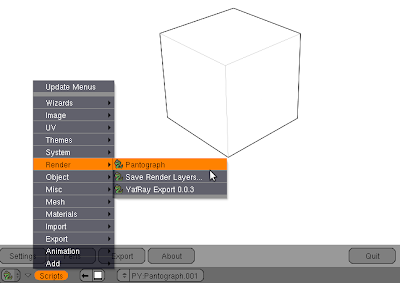Most Linux distributions ship IPython in their repositories. For example installing on Ubuntu is as easy as:
Getting IPython on Windows or Mac is simple if you have setuptools installed:$ sudo apt-get install ipython
Windows users should install pyreadline as well for autocompletion. Check first in a terminal if IPython is correctly installed:$ easy_install IPython
Save the following code as 'ipython_terminal.py' in your blender home script folder (~/.blender/scripts).$ ipython
Python 2.5.2 (r252:60911, Oct 5 2008, 19:24:49)
Type "copyright", "credits" or "license" for more information.
IPython 0.8.4 -- An enhanced Interactive Python.
? -> Introduction and overview of IPython's features.
%quickref -> Quick reference.
help -> Python's own help system.
object? -> Details about 'object'. ?object also works, ?? prints more.
In [1]:
Make sure you start Blender from a terminal and not from the start menu, as IPython will run in the terminal. You can start the IPython terminal from the Script window in Blender. (Scripts > System > Ipython (Terminal) ) Just like in my previous blog post, each time a Python statement is entered, the Blender window is updated. So you can move a cube and see the result, if you type:#!BPY
"""
Name: 'IPython (Terminal) - Enhanced Interactive Python Shell in Terminal'
Blender: 248
Group: 'System'
Tooltip: 'Interactive Python Console in terminal'
"""
__author__ = "Stani (SPE Python IDE)"
__url__ = ["pythonide.stani.be", "www.blender.org", "www.python.org"]
__bpydoc__ = """\
This only works if you started Blender from a terminal.
Otherwise Blender will freeze. The IPython console will
appear in the terminal. The namespace will be persistent
between console sessions within one Blender session.
Press Ctrl-D to pause the IPython session and return to Blender.
"""
# -*- coding: UTF-8 -*-
# ar - ARchitecture library
# Copyright (C) 2009 www.stani.be
#
# This program is free software: you can redistribute it and/or modify
# it under the terms of the GNU General Public License as published by
# the Free Software Foundation, either version 3 of the License, or
# (at your option) any later version.
#
# This program is distributed in the hope that it will be useful,
# but WITHOUT ANY WARRANTY; without even the implied warranty of
# MERCHANTABILITY or FITNESS FOR A PARTICULAR PURPOSE. See the
# GNU General Public License for more details.
#
# You should have received a copy of the GNU General Public License
# along with this program. If not, see http://www.gnu.org/licenses/
import sys
from IPython.Shell import IPShell
import bpy
import Blender
try:
shell = Blender.Registry.GetKey('ipython.terminal')['shell']
shell.IP.exit_now = False # resume
except TypeError:
sys_argv = sys.argv
sys.argv = ['/usr/bin/ipython']
shell = IPShell(user_ns={'Blender':Blender, 'bpy':bpy})
sys.argv = sys_argv
def pre_prompt_hook(ip, Blender=Blender, shell=shell):
Blender.Redraw()
Blender.Registry.SetKey('ipython.terminal', {'shell':shell})
shell.IP.set_hook('pre_prompt_hook',pre_prompt_hook)
shell.mainloop(banner=shell.IP.BANNER + shell.IP.banner2 +\
'\nPress Ctrl-D to pause the IPython session and ' +\
'return to Blender.\n')
When you want to return to Blender, press Ctrl-D. If you restart later the IPython terminal, it will remember any commands you have typed or any variables you have declared (like cube in the example).In [1]: cube = bpy.data.objects['Cube']
In [2]: cube.LocX = -1
IPython has a different prompt which makes it easy to go back to previous input statements or output values:
If you prefer a standard python prompt (>>>), just enter '%doctest_mode':In [1]: a=1
In [2]: print a
1
In [3]: a
Out[3]: 1
In [4]: exec _i2 # execute second command
1
In [5]: exec In[2:4] # execute multiple previous commands
1
In [6]: b=_3 # third ouput value
In [7]: a==b
Out[7]: True
For auto completion, press the TAB key:In [1]: %doctest_mode
*** Pasting of code with ">>>" or "..." has been enabled.
Exception reporting mode: Plain
Doctest mode is: ON
>>>
As shown in the last example auto completion works even for import statements.In [1]: bpy.data.
bpy.data.__class__ bpy.data.curves
bpy.data.__delattr__ bpy.data.fonts
bpy.data.__dict__ bpy.data.groups
bpy.data.__doc__ bpy.data.images
bpy.data.__getattribute__ bpy.data.ipos
bpy.data.__hash__ bpy.data.lamps
bpy.data.__init__ bpy.data.lattices
bpy.data.__name__ bpy.data.materials
bpy.data.__new__ bpy.data.meshes
bpy.data.__reduce__ bpy.data.metaballs
bpy.data.__reduce_ex__ bpy.data.objects
bpy.data.__repr__ bpy.data.scenes
bpy.data.__setattr__ bpy.data.sounds
bpy.data.__str__ bpy.data.texts
bpy.data.actions bpy.data.textures
bpy.data.armatures bpy.data.worlds
bpy.data.cameras
In [1]: bpy.data.m
bpy.data.materials bpy.data.meshes bpy.data.metaballs
In [1]: from Blender import M
Material Mathutils Mesh Metaball Modifier
Altough the Blender window updates itself, the Blender user interface is still irresponsive when running an IPython session. In a future blog post I'll show how to run IPython inside the Blender window in such way that the user interface stays fully responsive.
